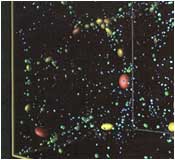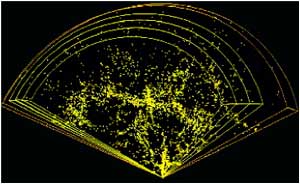The Evolution of Structure in the Universe
Studies of the chilly microwave glow that fills all of space reveal that the early universe was a nearly smooth blend of matter and energy. For many millions of years after the first atoms formed, this almost featureless young cosmos lacked stars and galaxies. But the visible universe today contains more than 100 billion galaxies, arrayed through space in gigantic clusters that seem to form spidery webs of matter. How did they arise?
Theories suggest that tiny gravitational differences from place to place in the infant universe started a snowballing process, gradually pulling matter together into individual stars, galaxies, and clusters of galaxies. For objects the size of galaxies and larger, the powerful gravitational pull of dark matter  played the key role in forging the structures that we see in the cosmos today. played the key role in forging the structures that we see in the cosmos today.
|
  |
Cosmologists create three-dimensional simulations on supercomputers to mimic the development of structure in the universe, a process that took billions of years in real time. These two sections of the simulation show the same region of the universe across a span of 8 billion years. The colorful blobs represent groups of galaxies and their associated halos of dark matter  . Red blobs contain the most massive concentrations of galaxies; blue ones are the least massive shown. When the universe was about 5 billion years old (left), large structures had begun to form under the relentless long-range influence of gravity. Today, 13 billion years after the Big Bang (right), the simulation shows chains and sheets of galaxy clusters separated by enormous voids. . Red blobs contain the most massive concentrations of galaxies; blue ones are the least massive shown. When the universe was about 5 billion years old (left), large structures had begun to form under the relentless long-range influence of gravity. Today, 13 billion years after the Big Bang (right), the simulation shows chains and sheets of galaxy clusters separated by enormous voids.
|

This telescopic survey of the locations of galaxies in the universe today reveals that they do indeed form clusters and sheets in space. The yellow dots are thousands of galaxies extending into space for a few hundred million light-years, with Earth at the bottom point of the wedge. Our once-smooth universe is now riddled by vast clumps and voids.
|
 MACHO passing directly in front of a distant star creates a tiny gravitational lens. We see the star's light spike upward brightly for a few hours or days. These events are so rare that special telescopic systems must monitor millions of stars at once to catch one in action. As technology improves, astronomers are seeing a growing number of minilensing events. However, the jury is still out on what's causing them. MACHO passing directly in front of a distant star creates a tiny gravitational lens. We see the star's light spike upward brightly for a few hours or days. These events are so rare that special telescopic systems must monitor millions of stars at once to catch one in action. As technology improves, astronomers are seeing a growing number of minilensing events. However, the jury is still out on what's causing them.
Even if MACHOs  are common, they might add just a percent or two to the total mass of the universe. Far more important, most astrophysicists believe, are the contributions of tiny particles. Neutrinos are common, they might add just a percent or two to the total mass of the universe. Far more important, most astrophysicists believe, are the contributions of tiny particles. Neutrinos  are a strong choice. These flecks, members in good standing of the standard model are a strong choice. These flecks, members in good standing of the standard model  , stream from all nuclear reactions. That includes fusion in the core of the Sun and the collapse of matter in supernovas , stream from all nuclear reactions. That includes fusion in the core of the Sun and the collapse of matter in supernovas  , which unleash Neutrinos , which unleash Neutrinos  in whopping numbers. Long presumed to be massless, Neutrinos in whopping numbers. Long presumed to be massless, Neutrinos  may possess the barest whisper of mass may possess the barest whisper of mass  , according to recent experiments. The evidence comes from detecting subtle changes in a few Neutrinos , according to recent experiments. The evidence comes from detecting subtle changes in a few Neutrinos  as they pass through Earth. A tiny fraction oscillates as they pass through Earth. A tiny fraction oscillates  between two types of matter described by the standard model between two types of matter described by the standard model  . That transformation is possible only if a neutrino carries some heft--but, mind you, perhaps 100,000 times less than electrons. Even with such tiny scale readings, all the Neutrinos . That transformation is possible only if a neutrino carries some heft--but, mind you, perhaps 100,000 times less than electrons. Even with such tiny scale readings, all the Neutrinos  in the universe might outweigh the total mass of stars and galaxies. in the universe might outweigh the total mass of stars and galaxies.
Other dark-matter candidates have earned the dubious honor of being called WIMPs  , for "weakly interacting massive particles." String theory , for "weakly interacting massive particles." String theory  predicts supersymmetric particles as partners to every bit of matter and every force-carrying particle in the universe. If that's true, those "sparticles predicts supersymmetric particles as partners to every bit of matter and every force-carrying particle in the universe. If that's true, those "sparticles  " (as they are known) exist all around us. They may begin to interact with the matter we know only at very high energies, perhaps beyond the reach of existing accelerators. It's a compelling goose chase. Many physicists suspect that much of the dark matter " (as they are known) exist all around us. They may begin to interact with the matter we know only at very high energies, perhaps beyond the reach of existing accelerators. It's a compelling goose chase. Many physicists suspect that much of the dark matter  will consist of completely unknown particles, thus extending the standard model will consist of completely unknown particles, thus extending the standard model  in new and exciting ways. in new and exciting ways.
All this fuss about dark matter  is driven by two factors. One simply is our insatiable curiosity about the nature of our universe. Ignorance of 99 percent of the cosmos doesn't sit well with most people, especially astrophysicists. The other is our obsession with fate. And dark matter is driven by two factors. One simply is our insatiable curiosity about the nature of our universe. Ignorance of 99 percent of the cosmos doesn't sit well with most people, especially astrophysicists. The other is our obsession with fate. And dark matter  , like it or not, controls our fate. Specifically, the amount of matter in the universe determines whether space will continue to expand forever or collapse back in on itself from the force of gravity , like it or not, controls our fate. Specifically, the amount of matter in the universe determines whether space will continue to expand forever or collapse back in on itself from the force of gravity  . We call these (continued) . We call these (continued) |

